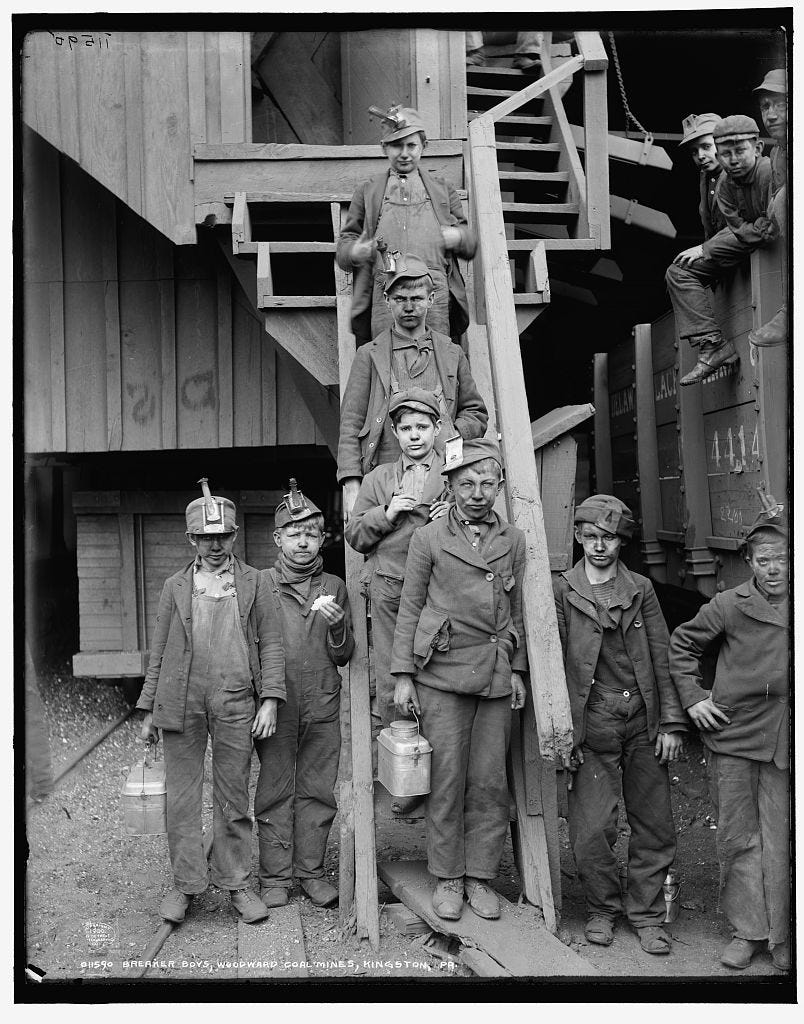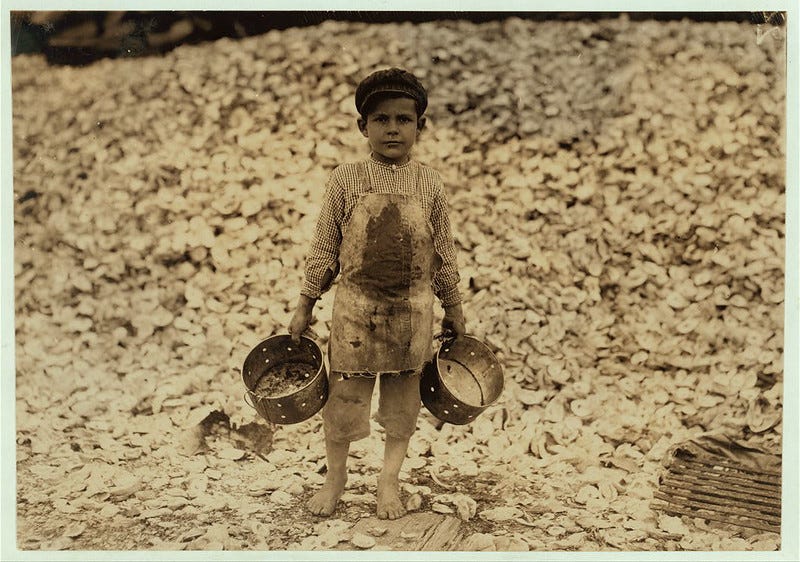Exploiting the Innocent
Child Labor’s Grim Return

It’s tempting to think of child labor as a relic of the past, immortalized in Louis Hine’s haunting photographs of soot-covered boys in coal mines and weary girls bent over textile looms.
Yet, the resurgence of efforts to weaken child labor protections in the United States reveals a startling truth: the battle fought—and seemingly won—more than a century ago is far from over.
Leading this effort is Project 2025, the far-right authoritarian playbook from the Heritage Foundation, that disguises its push to weaken federal child labor protections as promoting ‘parental rights.’
By shifting control to states, it paves the way for Republican-led states to further erode protections—loosening restrictions on dangerous jobs, extending work hours for minors, and reducing oversight, all under the banner of local control.

This rhetoric, advocating for families and states to decide on child labor standards, eerily mirrors the arguments used in the early 1900s to justify exploitation.
Then, as now, children’s welfare is sacrificed to economic interests, with industries like construction and meatpacking relying on cheap, flexible labor to fill dangerous roles.

The Grim History of Child Labor
To understand the stakes, we must revisit the horrors of child labor during America’s industrialization. In the late 19th and early 20th centuries, children as young as eight worked grueling hours in factories, mines, and fields.

The conditions were appalling: dangerous machinery, toxic environments, and endless shifts that robbed children of education and stunted their physical and emotional growth.
Families, desperate for survival, often had no choice but to send their children to work, especially in regions like Appalachia, where coal mines dominated local economies.

Against this bleak backdrop, Louis Hine, a sociologist-turned-photographer, became a pivotal figure in the fight for reform. Partnering with the National Child Labor Committee (NCLC), Hine documented the brutal realities of child labor.
His images of tiny boys wielding oversized tools or barefoot girls slumped over factory equipment shocked the public and fueled outrage.

Hine’s photographs weren’t just art—they were ammunition.
Legal Battles for Reform
Early attempts to curb child labor faced fierce resistance. The Keating-Owen Act of 1916, the first federal attempt to regulate child labor, was struck down in Dagenhart v. Keating-Owen (1918).
The Supreme Court sided with industrialists, citing federal overreach and defending state and parental rights.

Subsequent efforts, like the 1919 Child Labor Tax Law, met a similar fate, and a proposed Child Labor Amendment in 1924 failed to gain state support.
Business groups waged aggressive campaigns, invoking fears of federal intrusion into family life.
It wasn’t until the New Deal era that reformers succeeded. The Fair Labor Standards Act (FLSA) of 1938 established federal minimum age requirements and banned children from hazardous industries. It remains the cornerstone of child labor protections today.

The Modern Rollback of Protections
Decades later, the protections established by the FLSA are under attack. Project 2025 proposes lifting federal restrictions on hazardous work for minors and shifting decision-making to parents.
The argument? That federal bans contribute to labor shortages in industries like construction and meatpacking.
This Project 2025 push has been preceded by a wave of Republican-sponsored, state-level rollbacks:
• Arkansas eliminated work permits for minors under 16, citing parental rights.
• Iowa proposed allowing 14- and 15-year-olds to work in industrial laundries and meatpacking plants.
• Nebraska introduced a subminimum wage for minors.
• Ohio extended allowable working hours for teenagers, enabling late-night shifts in hazardous industries.

These rollbacks align with a troubling trend: a reported 88% increase in child labor violations from 2019 to 2023. Many cases involve undocumented children working long hours in dangerous environments like meatpacking plants, often hidden from public view.
Industries reliant on cheap labor—agriculture, construction, and meatpacking—have become adept at exploiting this vulnerable workforce under the radar of oversight.

Learning from History
The resurgence of child labor exploitation serves as a stark reminder of history’s cyclical nature. Just as Louis Hine and the NCLC fought against industrialists prioritizing profit over children’s welfare, today’s advocates face similar challenges.

“Parental rights” rhetoric masks the true economic motives driving these rollbacks. History has shown us that without robust protections, children bear the cost—not just in lost education, but in lives marked by exploitation and danger.
The stakes are clear: rolling back these protections risks reversing over a century of progress. We must draw inspiration from past victories, demand accountability from policymakers, and recommit to safeguarding children from exploitation.
If history teaches us anything, it’s that the fight for justice requires vigilance, persistence, and the courage to put children’s welfare above economic gain.



When I was growing up in rural SW Va in the 1970s and 80s,I knew a whole generations of older relatives and other people their age,born and raised in the early 20th century,that this article perfectly described.They talked of working in the fields or doing other farmwork as barely toddler age,and if they had the chance to go to school,most barely got past 2nd-3rd grade, couldn't read a word,could barely scrawl their name on a document,and I was one of many younger kids who did their paperwork and read their mail to them.I witnessed"X"signatures on documents long before it was legal for me to do so,because I was the only available person to do so,that could read and write.
Kids weren't expected to need to be sent to school,there were no truancy laws,or laws that compelled parents to send their kids to school regularly(the current age for that is 6-16,no matter where you live.)
When the child labor laws changed,so did the laws mandating school attendance.I now believe the lax child labor laws that are cropping up,and the government suddenly wanting to abolish the Department of Education,is no accident.They want these kids working,not attending school and learning,and to prevent parents from getting in trouble doing this.
This needs to be promoted far and wide,and not let this happen under the radar.Our kids deserve better.
I hope modern photo-journalists in the United States are hard at work documenting children working in meatpacking plants, agriculture and other dangerous and exhausting jobs, in defiance of both law and ethics. Rolling back workers' protections is iniquitous, all the more so when it puts children to work long hours in harmful environments.